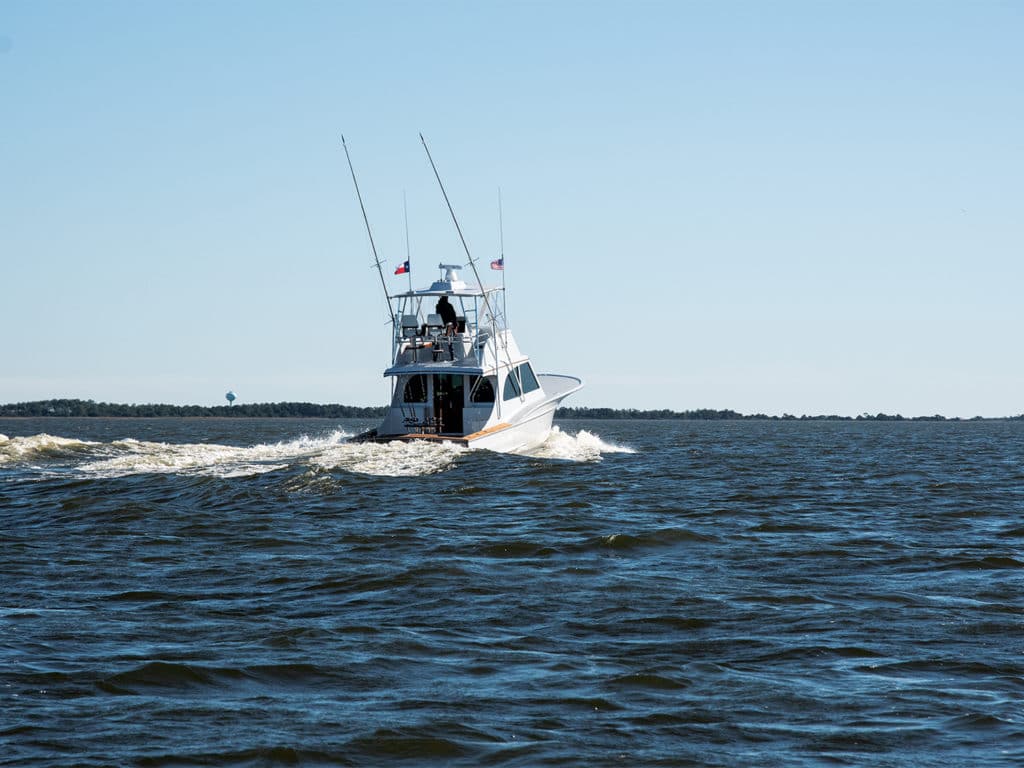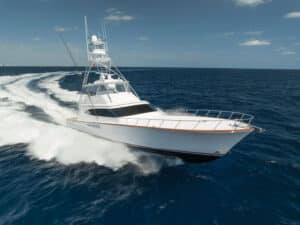
Patrice Marie is a custom battlewagon that is perfect for an owner who wants to operate his own vessel, and her retro lines pay homage to the pioneers of Carolina boatbuilding and design by the likes of Warren O’Neal, Omie Tillett, and Glenn “Peanut” Haught. After owning a 39-foot Harrison express for the past five years, the owner absolutely knew whom he would contact for a slightly larger convertible for the 100-plus-mile runs and sea conditions he frequently encounters off the Texas coast. Enter the Harrison 41.
Patrick Harrison grew up fishing the waters of Oregon Inlet, beginning his career as a fish cleaner at the venerable Oregon Inlet Fishing Center while attending college. His eye was drawn to the style and function of the local charter boats, so after college, he worked with Robin Smith for five years, then ventured out on his own. Harrison has been building and renovating boats for the past 20 years, and is a skilled woodworker at heart; the way he constructs his boats is evidence of his passion. Patrice Marie is the largest build to date for Harrison Boatworks, which is located in Wanchese, North Carolina, and was designed as a throwback to the earlier days, with a three-panel house and bridge as well as front windows that allow for a lower station. Her lines are simple yet elegant.

Cockpit and Mezzanine
The cockpit is exactly what would be expected with a custom Carolina build. Highlighting the six-rod Release Marine rocket launcher are teak covering boards and coamings, while the teak cockpit deck and mezzanine step—hosting two boxes against the aft bulkhead—ensure stable footing in the wettest conditions. Continuing with simplicity, the port side houses an ice chest with no ice maker or chiller. Another throwback is located in the starboard box, which contains a complete third station with a 9-inch Garmin multifunctional display and remotes for the teaser reels that are mounted in the hardtop. This feature allows the owner and one other person to fish on days when additional crew is unavailable. Completing the starboard side of the mezzanine is tackle and general storage. The centerline mezzanine hatch gives access to the Seakeeper 6 for ease of maintenance.

Salon and Galley
Entering the salon through the Hafele sliding door is another throwback to yesteryear. The double door slides to each side of the aft bulkhead; the mechanism is smooth and the glide precise, allowing for a soft close even in the roughest seas. An interesting twist to the doors is the two different types of wood that are utilized. To match the cockpit features, the exterior is crafted with teak, while the interior of the door is constructed of sapele mahogany, highlighting the exposed sapele house-support beams overhead, as well as the window trim, fiddle rails and helm pod. The salon layout is spacious and simple, with storage throughout. The flooring is laid with cork, making cleanup quick, as well as feeling soft on the feet. The cork also acts as sound insulation for the twin Cummins QSB6.7 engines.
Watch: Learn to make a bonito strip teaser here.
Immediately to starboard, the two-person love seat houses a Brownie dive compressor—complete with 150-foot hoses—to make diving with a small crew easy and safe. The galley to starboard contains a refrigerator/freezer and microwave, with a single stainless sink on the countertop. An L-shaped sofa is to port, with two Release Marine helm chairs rounding out the salon station.
Standard electronics are contained in this helm station, including a 16-inch Garmin MFD, Icom VHF, Simrad autopilot, Fusion marine stereo and Zipwake trim-tab controls.
Planning to fish with a small crew or just his wife, the owner has placed cameras throughout the boat that are synced to the Garmin displays—he can monitor the entire vessel from any of the three stations. Moving forward and below is a large, open area with rod storage directly overhead, and to starboard, a single bunk that can double as a sofa. Immediately to port is the massive head and shower, as well as a sizable tackle center that boasts drawers and cabinets for storage and a large countertop for rigging. Moving all the way forward, there is a V-berth with storage below and internal access to the anchor locker.
Maintaining the theme of classic simplicity, the interior walls are beautifully faired and expertly painted with Awlgrip, and the forward deck support beams are exposed sapele, just as they are in the salon. The sapele trim and fiddles add a nice cohesive touch throughout the boat’s interior.

Engine Room and Bridge
The engine room contains two compact 550 hp Cummins engines paired to Twin Disc gears. Accessing the space is easy thanks to a massive centerline hatch in the salon. Also found in the engine room is a 10-kilowatt Westerbeke generator, instant hot-water heater, toolbox and battery chargers. The space is clean and neatly finished in glossy Cloud White Awlgrip, and has generous working room, despite being only a 41-foot boat.
The bridge continues in the style of the early Carolina boats, with a narrow center console and a single Release helm chair accompanied by bench seats on either side against the bridge wings, with the safety equipment and additional rod storage located in the brow.
Complementing the retro look, the electronics panel rises just beyond the teak helm pod and is laid out efficiently, housing many items within a small footprint. The focal point is the single 16-inch Garmin MFD with GPS, sonar and radar. An Icom VHF radio, Fusion stereo remote, engine displays and a Blue Sea tank monitoring panel round out the suite. Above the helm chair, a sliding hatch reveals two Miya Epoch US-9R teaser reels, and just aft of that are two pancake-style teaser reels.

Construction
Harrison relies on the traditional methods of construction, utilizing okoume plywood for the hull. The stringers and keel are constructed from Douglas fir, while the chine, sheer clamp and battens are made of Spanish cedar, which is used for its bendability and for the wood’s natural water resistance; everything is fully encapsulated with biaxial fiberglass and West System-brand epoxy.
Read Next: Learn more about the birth of Carolina-style sportfishermen here.
Performance
Efficiency was an important consideration to this build, and the Cummins engines deliver speed and offer amazing fuel consumption. Patrice Marie will stay on plane at 12 knots—an advantageous trait when seas or inlet crossings are precarious. At 25 knots, she’s burning just 24 gallons per hour; bump up the throttles to 30 knots, and she’s sipping 40 gph. Her fully loaded top-end speed is 35 knots, burning 54 gph.
Patrice Marie is a beautiful example of a modern Carolina sport-fisher that highlights the features and lines from boats built in the 1970s and ’80s. Whether you see her in Port Aransas, Texas, or in the Bahamas, she will take many of us back to a much simpler time, with a look similar to where it all began.







